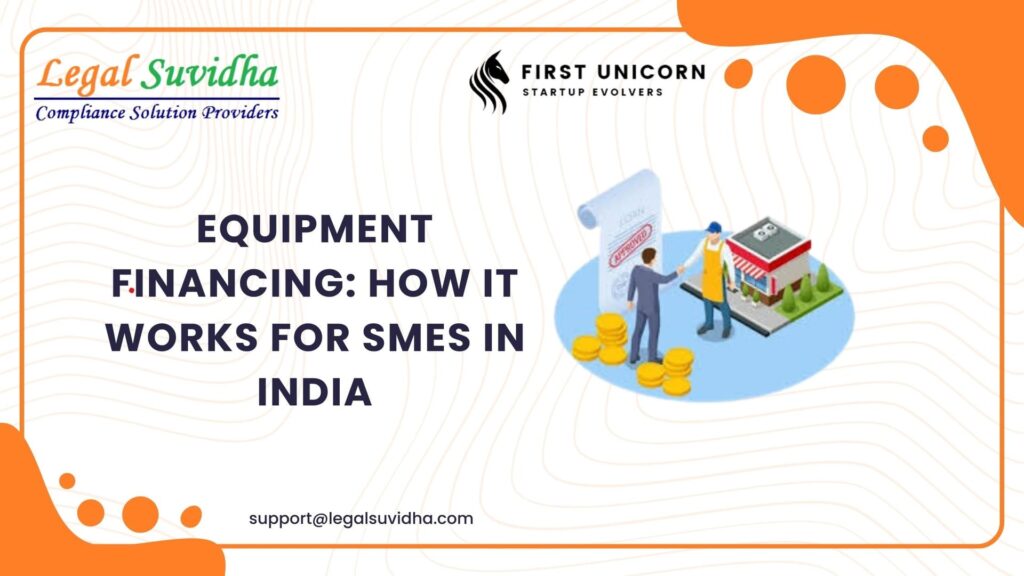Equipment Financing: How It Works for SMEs in India
1. Introduction
Equipment financing plays a pivotal role in helping small and medium enterprises (SMEs) in India acquire the tools and machinery necessary for business operations. This guide explores the ins and outs of equipment financing, helping business owners make informed decisions.
2. What is Equipment Financing?
Equipment financing refers to loans or leases designed specifically for acquiring equipment, machinery, or tools essential for business operations. This type of financing offers tailored terms and conditions, covering diverse equipment types like construction machinery, IT hardware, medical tools, and more.
3. How Equipment Financing Works in India
- Application: Submit an application to a lender with required documents.
- Evaluation: The lender assesses creditworthiness and the equipment’s value.
- Approval: Approved funds are disbursed directly to the supplier.
- Repayment: Loan is repaid in installments as per terms.
Banks, NBFCs, and fintech firms provide equipment financing, with Loan-to-Value (LTV) ratios ranging from 70% to 100%.
4. Benefits of Equipment Financing for SMEs
- Preserves Cash Flow: Avoid upfront payments by spreading costs.
- Tax Benefits: Claim interest payments and depreciation as deductions.
- Increased Productivity: Access modern equipment for better efficiency.
- Flexible Terms: Custom repayment schedules align with cash flow.
5. Types of Equipment Financing
- Loan-Based Financing: Ownership transfers upon repayment.
- Lease Financing: Use equipment by paying periodic lease amounts.
- Hire Purchase: Ownership is transferred after payments.
- Vendor Financing: Sellers partner with lenders for financing solutions.
6. Eligibility Criteria for Equipment Financing in India
- Business History: Minimum 1-3 years of operation.
- Financial Health: Stable turnover and profitability.
- Credit Score: 650+ is ideal.
- Documentation: Business registration, financial statements, GST returns, equipment invoice.
7. Interest Rates and Loan Terms
Interest rates range from 8% to 16%, based on creditworthiness, equipment type, and tenure (1-7 years). Compare multiple lenders for the best terms.
8. Top Lenders Offering Equipment Financing in India
- Banks: SBI, HDFC Bank, ICICI Bank.
- NBFCs: Bajaj Finserv, Lendingkart, Tata Capital.
- Government Schemes: MUDRA Loans, CGTMSE.
9. Tax Benefits and Deductions
- Depreciation: Claim under Section 32 of the Income Tax Act.
- Interest Deductions: Deductible under Section 36.
- Leasing: Lease payments are business expenses.
10. Challenges Faced by SMEs in Equipment Financing
- High interest rates for new businesses.
- Stringent eligibility criteria.
- Limited awareness of schemes and benefits.
11. Tips for SMEs to Secure Equipment Financing
- Improve credit score for better rates.
- Prepare financial documents and GST returns.
- Choose lenders offering favorable terms.
12. Alternatives to Equipment Financing
- Business loans for machinery.
- Asset-backed loans.
- Peer-to-peer lending or crowdfunding.
13. Real-Life Success Stories
Case Study 1: A Gujarat-based textile SME secured SBI financing for looms, increasing production by 40%.
Case Study 2: An IT startup in Bengaluru leased servers, enabling scalable operations.
14. Conclusion
Equipment financing empowers SMEs in India to adopt modern technology without financial strain. Evaluate your options and choose the best solution for your business growth.
Looking for more insights or want to start your own startup?
Are you looking for Startup Funding/Grant/Loan for your Business? Fill the below attached form today!
https://forms.gle/R7t7zTQGjiKEFEu86


![Received an Income Tax Notice in India? Don’t Panic — Here’s Exactly What to Do [2025 Guide] 1 Income Tax Notice](https://legalsuvidha.com/wp-content/uploads/2025/12/Income-Tax-Notice.png)
![Cyber Crime FIR in India: How to File Complaint for Online Fraud, Banking Fraud & Digital Harassment [2025 Guide] 2 Cyber Crime Complaint](https://legalsuvidha.com/wp-content/uploads/2025/12/Cyber-Crime-Complaint.png)
![Trademark Infringement in India: How to File Legal Action & Protect Your Brand [2025 Guide] 3 Tradenark Infrigement](https://legalsuvidha.com/wp-content/uploads/2025/12/Tradenark-Infrigement.png)
![Property Title Verification in India: How to Check Clear Title in 7 Steps [Avoid Property Fraud – 2025 Guide] 4 Property Titles Verification](https://legalsuvidha.com/wp-content/uploads/2025/12/Property-Titles-Verification.png)



